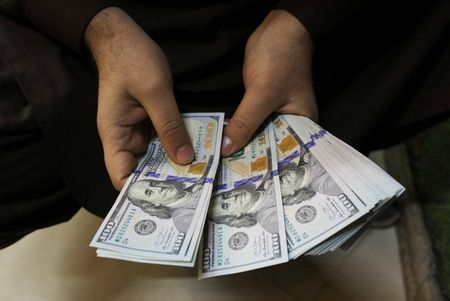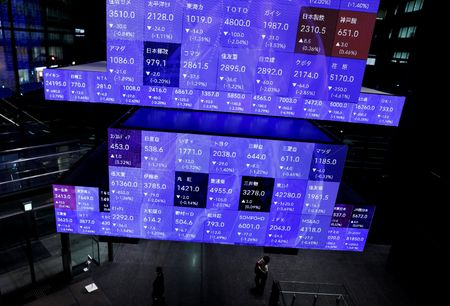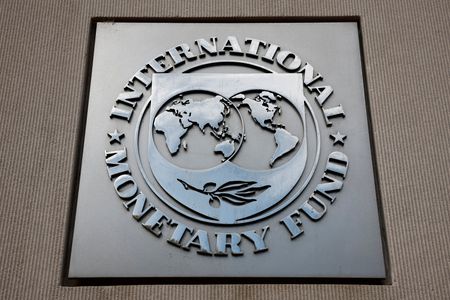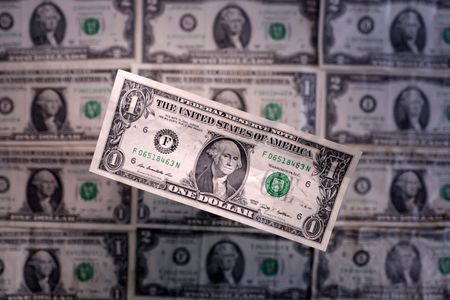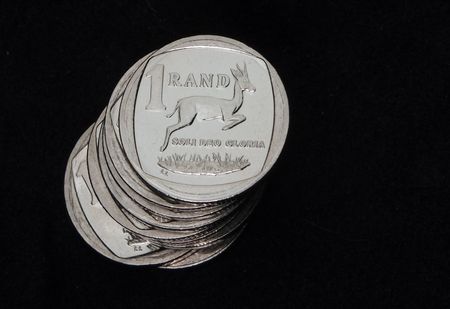By Chibuike Oguh
NEW YORK (Reuters) -The dollar strengthened against major peers on Wednesday after the Federal Reserve left U.S. interest rates unchanged, in line with market expectations but rebuffing pressure from President Donald Trump.
The Federal Open Market Committee voted 9-2 to keep its benchmark overnight interest rate steady in the 4.25%-4.50% range for the fifth consecutive meeting.
Both Vice Chair for Supervision Michelle Bowman and Governor Christopher Waller, who were appointed by Trump, dissented, preferring to lower rates by 25 basis points.
In his subsequent press briefing, Fed Chair Jerome Powell said he is expecting a slow process when it comes to understanding how trade tariffs impact inflation.
“The Fed’s decision to hold rates steady came as no surprise, though markets took note of two dissenting votes in favor of a cut,” said Uto Shinohara, senior investment strategist at Mesirow Currency Management in Chicago.
“The dollar remained well-supported following this morning’s stronger data and the Fed announcement, with the market pricing the September meeting as a coin-flip,” Shinohara added.
Earlier in the session, data showed that U.S. economic growth rebounded more than expected in the second quarter, expanding by 3% compared with an estimate of 2.4% based on a Reuters poll of economists.
The euro extended losses against the dollar following the Fed’s decision and as Powell spoke. It was last down 1% to $1.141775, on track for the fifth straight session of losses and trading at its lowest level since June 11.
The euro is also poised to record its first monthly drop in 2025, following a sharp reaction to a U.S.-European Union trade deal earlier this week.
The dollar index added to its gains after the Fed. It was up 0.96% at 99.82, hitting its highest level since May 29 and on course to post its first month of gains this year.
U.S. Treasury yields were mostly higher. The 2-year note yield, which typically moves in step with interest rate expectations for the Fed, rose 6.6 basis points to 3.941%.
“I think people are reading too much into the GDP numbers; nobody in markets should think GDP was that weak in Q1 and that strong in Q2 even though the big drivers were inventories and net exports,” said Steve Englander, head of global G10 FX Research at Standard Chartered in New York.
“I will add the two quarters together and they averaged about 1.5% GDP growth per quarter, which is not a recession but qualifies as mediocre.”
Trade agreements struck with Japan last week and the EU over the weekend signalled a renewed U.S. commitment to global engagement, easing investor concerns.
Investors’ focus is now on negotiations between China and the U.S. after officials agreed to seek an extension of their 90-day tariff truce. But Trump upped the ante against India and Brazil on Wednesday.
He announced that a 25% tariff on U.S. imports of Indian goods, starting on August 1 and signed an executive order implementing an additional 40% tariff on Brazil, bringing the total tariff amount to 50%.
Data showed on Wednesday that the German economy contracted in the second quarter, while France’s economy beat forecasts.
The spotlight will be on comments from BoJ Governor Kazuo Ueda as investors hope the trade deal between Japan and the U.S. paves the way for the central bank to raise rates on Thursday.
The dollar was 0.55% firmer to 149.29 against the yen, after hitting its highest since April 2. Against the Swiss franc, the dollar strengthened 0.82% to 0.81265 francs, reaching its highest since June 23.
(Reporting by Chibuike Oguh and Laura Matthews in New York and Stefano Rebaudo; Editing by Kate Mayberry, Bernadette Baum, Ros Russell, Frances Kerry and Sandra Maler)

